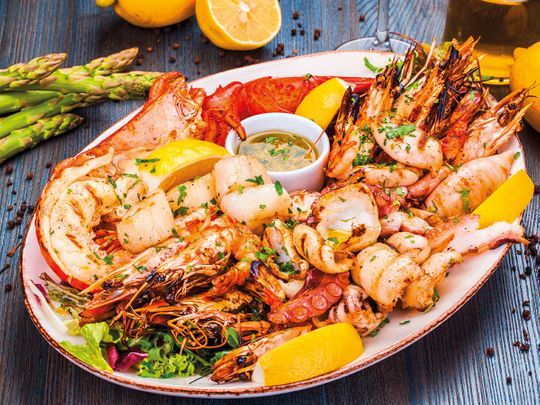
Dubai: So you have decided to eat sustainably. Where do you begin? Consider this: A 50-gramme serving of beef protein on your plate generates more than 17 kilogrammes of carbon dioxide (CO2). On the other hand, if you ditch the beef and opt for 50 gms of farmed fish, the CO2 load drops to about two and half kilogrammes. Compared with plant-based foods, meat and dairy have a bigger emissions footprint — accounting for 14.5 per cent of all greenhouse gases, according to studies. Kilo for kilo, production of animal protein takes up more energy, water and land than plant protein and newer studies are even docking dairy as a high carbon-footprint food. Be that as it may, the importance of assessing our diets has never been more pressing, not just for the planet’s health but for our own health too.
For some time now, nutrition experts have been drawing up a ranking of healthy meats, the order beginning with fish as the preferred source of protein, with poultry following and red meat of various origins taking up position lower down the scale.
In a study of the Danish population, researchers found that Danes could gain more than 7,000 years of healthy life annually if they ate the recommended quantity (12 ounces per week) of fish while replacing red and processed meats in their diet.
“It’s important to note that there is no one-size-fits-all healthier diet or meat per se,” says American physician nutrition specialist Janese Laster. Also crucial: “There are differences in farming practices, so throughout the US, [for example], each person is getting different risks and benefits from the meats.”
A significant study, the EAT-Lancet report, released in January this year was compiled by 37 scientists and other experts from 16 countries, with the aim of establishing a global food economy that could combat chronic diseases and provide better nutrition, and sustain the planet. The scientists’ goal was to outline a sustainable diet that could feed the nearly 10 billion people expected to inhabit the world by 2050.
The Lancet report does not insist that everyone become a vegetarian or vegan but urges people to make thoughtful choices in the amount and frequency of what they eat. It means taking a good look at the options of meats, red and white, available and choosing well.
“Meat is a complex nutrient food offering high quality protein, dietary cholesterol, and unsaturated fats,” says Juliot Vinolia, clinical dietician, Medeor24/7 Hospital, Dubai. “The vitamins present are B3 (niacin), B12 (cobalamin), B6 (pyridoxine). Iron, zinc, selenium and phosphorus are the minerals. Red meat also contains creatine and an amino acid, carnosine, both being essential nutrients for the brain and muscles. Each type of meat has its unique nutrients but it is the method of processing which makes it unhealthy, triggering inflammation in our body leading to chronic diseases.”
According to a 10-year cohort observational study published earlier this year in the European Journal of Epidemiology, says Vinolia, it was understood that red meat was not directly associated with mortality but processed red meat was. “There was no relation of poultry with cancer mortality. While fish intake showed positive association in disease prevention. Substituting processed meat with other fresh meat will decrease mortality risks.”
She ranks meats and details the pros and cons of each type of animal protein, along with their respective carbon footprints.
1. FISH, SEAFOOD, SHELLFISH
Plus: Low in saturated fats, rich in heart-friendly omega fatty acids, Vitamin E, D, Iodine, phosphorus and zinc.
Provides anti-inflammatory effects in disease prevention. Wild Alaskan salmon, oysters and sardines are highest in healthy fats; white fish such as cod or flounder tend to be leaner.
Minus: Mercury poisoning from certain varieties of fish. Processed fish in cans may come with a lot of carcinogenic preservatives.
Carbon footprint: Low
2. TURKEY
Plus: Good quality protein, B-complex vitamins B3, B6, B12, choline, selenium, zinc. Fairly comparable to chicken in nutrients, but both its dark and white meat are slightly leaner.
Minus: Contains less saturated fat than chicken. Processed turkey comes with high quantities of salt and carcinogenic preservatives.
Carbon footprint: Medium
3. CHICKEN
Plus: Less saturated fat than red meat. Good source of essential amino acids, niacin and iron. Skinless, boneless breast is leanest.
Minus: Antibiotic resistance may develop from eating regular commercially raised chickens which may be exposed to high levels of antibiotics.
Carbon footprint: Very low (compared to red meat). Replacing chicken with red meat can reduce carbon footprint by 50 per cent. They require less land, fertiliser and other resources, convert feed into meat efficiently.
4. GOAT
Plus: Lower in fat than chicken, higher in protein quality than beef. Low in saturated fat, and highest in iron content compared to all meat, making it healthier than all red meat.
Minus: Cancer-producing compounds may develop when cooking mutton on high temperatures for long duration, such as frying, slow grilling.
Carbon footprint: Medium (Goats are browsers, not grazers, and therefore have a much smaller impact on the land).
5. LAMB
Plus: Provides all nine essential amino acids, packed with iron, selenium, zinc , Vit B12 and phosphorus. Known for its conjugated linoleic acid (fatty acid) that reduces body fat mass. Loin, shank and leg cuts are leanest; some cuts of lamb are slightly higher in calories than beef, but you can trim fat from the edges to make them leaner.
Minus: It has more saturated fat than beef. Processed lamb may come with a lot of sodium and carcinogenic nitrites.
Carbon footprint: Very high. It’s the highest in animal protein.
6. BEEF
Plus: A complete amino acid profile similar to our body make-up of proteins in our muscles. Contains vitamins and minerals similar to other meats.
Minus: Predominantly saturated fat and cholesterol. Has bovine growth hormones and insulin-like growth factors which trigger chronic diseases. Carcinogenic compounds get formed on high-temperature cooking. Several studies have shown that high intake of processed red meat did have an strong link with many types of cancer, mainly of the colon.
Carbon footprint: High.
To yield 1kg of steak, a cow needs to eat 25 kgs of grains and 150,00 liters of water. The amount of grains fed to cows in livestock can actually be fed to 3.5 billion people.
While organic meat is healthier, its production according to several long- term ecological studies, left a higher carbon footprint than commercial livestock.
7. PROCESSED MEAT
Eg. sausages, nuggets, salted, cured, smoked, dried, canned.
Plus: Long shelf life, convenience and addictive flavour and texture.
Minus: Processing meat not only denatures the biological nutrients and minerals but also leads to the formation of several chemical compounds that increase inflammation and trigger cancer in our body.
Carbon footprint: High
What is carbon footprint?
It’s the volume of carbon dioxide released into the atmosphere as a result of the activities of a particular individual, organisation or community or making of a product or food. Too much of CO2 in the atmosphere leads to global warming and its domino effects on all livings things.

















